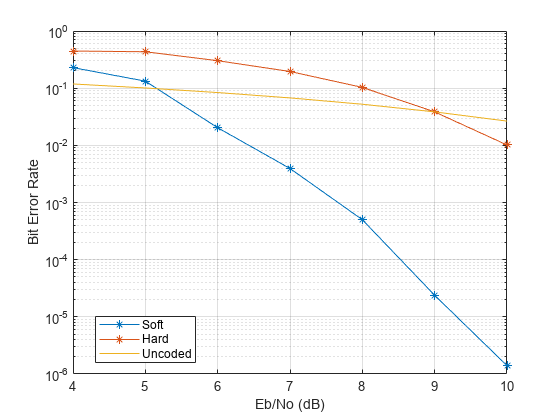Estimate BER for Hard and Soft Decision Viterbi Decoding
Estimate bit error rate (BER) performance for hard-decision and soft-decision Viterbi decoders in AWGN. Compare the performance to that of an uncoded 64-QAM link.
Set the simulation parameters.
rng default M = 64; % Modulation order k = log2(M); % Bits per symbol EbNoVec = (4:10)'; % Eb/No values (dB) numSymPerFrame = 1000; % Number of QAM symbols per frame
Initialize the BER results vectors.
berEstSoft = zeros(size(EbNoVec)); berEstHard = zeros(size(EbNoVec));
Set the trellis structure and traceback depth for a rate 1/2, constraint length 7, convolutional code.
trellis = poly2trellis(7,[171 133]); tbl = 32; rate = 1/2;
The main processing loops perform these steps:
Generate binary data
Convolutionally encode the data
Apply QAM modulation to the data symbols. Specify unit average power for the transmitted signal
Pass the modulated signal through an AWGN channel
Demodulate the received signal using hard decision and approximate LLR methods. Specify unit average power for the received signal
Viterbi decode the signals using hard and unquantized methods
Calculate the number of bit errors
The while loop continues to process data until either 100 errors are encountered or bits are transmitted.
for n = 1:length(EbNoVec) % Convert Eb/No to SNR snrdB = EbNoVec(n) + 10*log10(k*rate); % Noise variance calculation for unity average signal power noiseVar = 10.^(-snrdB/10); % Reset the error and bit counters [numErrsSoft,numErrsHard,numBits] = deal(0); while numErrsSoft < 100 && numBits < 1e7 % Generate binary data and convert to symbols dataIn = randi([0 1],numSymPerFrame*k,1); % Convolutionally encode the data dataEnc = convenc(dataIn,trellis); % QAM modulate txSig = qammod(dataEnc,M, ... InputType='bit', ... UnitAveragePower=true); % Pass through AWGN channel rxSig = awgn(txSig,snrdB,'measured'); % Demodulate the noisy signal using hard decision (bit) and % soft decision (approximate LLR) approaches. rxDataHard = qamdemod(rxSig,M, ... OutputType='bit', ... UnitAveragePower=true); rxDataSoft = qamdemod(rxSig,M, ... OutputType='approxllr', ... UnitAveragePower=true, ... NoiseVariance=noiseVar); % Viterbi decode the demodulated data dataHard = vitdec(rxDataHard,trellis,tbl,'cont','hard'); dataSoft = vitdec(rxDataSoft,trellis,tbl,'cont','unquant'); % Calculate the number of bit errors in the frame. % Adjust for the decoding delay, which is equal to % the traceback depth. numErrsInFrameHard = ... biterr(dataIn(1:end-tbl),dataHard(tbl+1:end)); numErrsInFrameSoft = ... biterr(dataIn(1:end-tbl),dataSoft(tbl+1:end)); % Increment the error and bit counters numErrsHard = numErrsHard + numErrsInFrameHard; numErrsSoft = numErrsSoft + numErrsInFrameSoft; numBits = numBits + numSymPerFrame*k; end % Estimate the BER for both methods berEstSoft(n) = numErrsSoft/numBits; berEstHard(n) = numErrsHard/numBits; end
Plot the estimated hard and soft BER data. Plot the theoretical performance for an uncoded 64-QAM channel.
semilogy(EbNoVec,[berEstSoft berEstHard],'-*') hold on semilogy(EbNoVec,berawgn(EbNoVec,'qam',M)) legend('Soft','Hard','Uncoded','location','best') grid xlabel('Eb/No (dB)') ylabel('Bit Error Rate')

As expected, the soft decision decoding produces the best results.